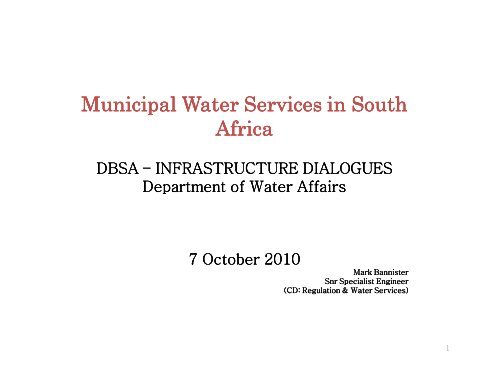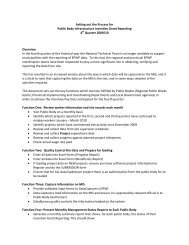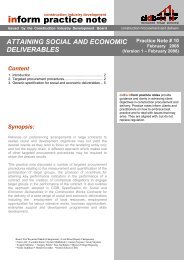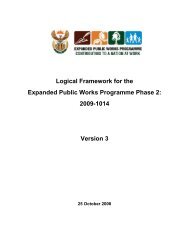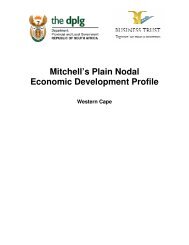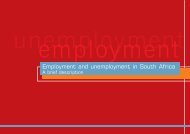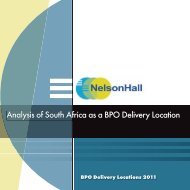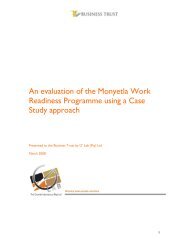Municipal Water Services in South Africa
Municipal Water Services in South Africa
Municipal Water Services in South Africa
You also want an ePaper? Increase the reach of your titles
YUMPU automatically turns print PDFs into web optimized ePapers that Google loves.
Resource Overview2
Current water availabilityAt 98% assurance level, SA water isconstituted as follows:• 77% surface resources• 9% ground water• 14% return flows• Desal<strong>in</strong>ation < 1%3
<strong>Water</strong> availability4
<strong>Water</strong> requirements5
<strong>Water</strong> Use per economicsector6
<strong>Water</strong> <strong>Services</strong>7
national governmentSector Overview: Institutionalwater resourcemanagementchargemunicipal <strong>in</strong>frastructure grantlocal government equitable sharecapacity build<strong>in</strong>g grantwater services sectorprimary mechanismsfor national redistributioncatchmentmanagementagencywater services authoritysets retail tariff policy,sets retail tariffs,determ<strong>in</strong>es local subsidy framework<strong>in</strong>direct subsidypayment <strong>in</strong> terms of service delivery agreementagencysupply<strong>in</strong>graw waterraw water tariff(or water resourcedevelopmentcharge)water services providerdirect or <strong>in</strong>direct subsidy payment for services receiveddirect subsidyconsumerKey: payments national subsidies local subsidies8
Bodies forInternationalAgreementsStatutory &AccountabilityM<strong>in</strong>isterDWA Head OfficeStatutory &AccountabilityNWRIA+TCTACooperation &consultationStatutory &AccountabilityRegionsStatutory &AccountabilityStatutory &AccountabilityWRCCMAStatutory &AccountabilityRegulatory &Support<strong>Water</strong>BoardsCooperation &consultationRepresentation &CooperationWSAContractualAccountabilityContractualWUAWSP<strong>Municipal</strong>Entity9
Access to basic water services• MDG:– Halve the basic services backlog by 2015• <strong>Africa</strong>:– Support AU and AMCOW 2015 drive• <strong>South</strong> <strong>Africa</strong>:– Ensure all people <strong>in</strong> <strong>South</strong> <strong>Africa</strong> have access to Susta<strong>in</strong>able Basicwater supply and sanitation by 201410
SA -% Households with Access to:<strong>Water</strong>, Sanitation & Cell Phones% HH Coverage as % of HH59%48%% Households with Access to <strong>Water</strong>73%79%72.9% <strong>in</strong> 2008% Households Access to Sanitation32.2%% Households with Access to Cell Phones1994 2001 201093%11
Formal Historic Basic <strong>Water</strong> Service ChallengesGROUNDWATER & WATER QUALITY CHALLENGE•Scattered rural settlements (high poverty)• Low economic development potential• Groundwater dependent (with water quality risks)• Limited surface water development potential•<strong>Water</strong> reticulation needs (with O&M challenges)WATER AVAILABILITY CHALLENGE•Extensive water backlogs (villages)• <strong>Water</strong> stressed areas• Local WR limitations• <strong>Water</strong> quality challenges• <strong>Water</strong> demand management need• Requires WR development(De Hoop & others)• Requires major regional bulk <strong>in</strong>fra• High capital and O&M cost• Major fund<strong>in</strong>g needsCONTEXT of CHALLENGE• water availability and accessibility• topographic and physical challengesimpact<strong>in</strong>g on capital and operat<strong>in</strong>gcosts• bulk <strong>in</strong>frastructure dependency withassociated fund<strong>in</strong>g andimplementation time frames• total life-cycle management withassociated skills and susta<strong>in</strong>ablemanagement• phased approach provid<strong>in</strong>g for<strong>in</strong>terim solutions while address<strong>in</strong>glonger-term susta<strong>in</strong>able developmentWATER DISTRIBUTION CHALLENGE•Extensive water backlogs (scattered)• With<strong>in</strong> water-rich WMA (but no access)• Requires WR developments• Requires major regional bulk <strong>in</strong>fra• High capital and O&M cost (topography)• Major fund<strong>in</strong>g needs12
Urban <strong>Water</strong> <strong>Services</strong> Challenges & PerspectivesKEY URBAN WATER SERVICES CHALLENGES• Major urbanization and densification <strong>in</strong> ma<strong>in</strong>urban areas with associated “new” basic servicesneeds (hous<strong>in</strong>g) and associated economic growthand higher levels of services.• Internal bulk <strong>in</strong>frastructure challenges withassociated service quality challenges (e.g. dr<strong>in</strong>k<strong>in</strong>gwater quality, wastewater management,<strong>in</strong>terruptions, effective use, loss prevention andasset management)•Environmental impacts and risks (e.g. urban riverquality, health and recreation)13
WSA FINANCIAL FRAMEWORKOperat<strong>in</strong>g grants(Primarily equitableshare)Capitalgrants(MIG)OPERATINGCAPITALOwn sources(user charges;rates; levies etc.)BasicserviceHigher servicelevelOwn sources(capital funds,loans etc.)14
Pr<strong>in</strong>ciples for <strong>in</strong>stitutional reform• ensure the provision of an appropriate level of waterand sanitation services which are susta<strong>in</strong>able to allhouseholds <strong>in</strong> <strong>South</strong> <strong>Africa</strong> and to implement the freebasic water and sanitation policies effectively andefficiently;• ensure quality Asset Management and effectiveOperation & Ma<strong>in</strong>tenance of <strong>in</strong>frastructure that willcontribute towards susta<strong>in</strong>ability• improve the performance of water services providers;• improve the f<strong>in</strong>ancial viability and susta<strong>in</strong>ability ofthe water services sector by significantly enhanc<strong>in</strong>grevenue collection (from those who use <strong>in</strong> excess of abasic service) and improv<strong>in</strong>g consumer management;• improve the accountability of water servicesproviders to water services authorities and toconsumers;15
Pr<strong>in</strong>ciples for <strong>in</strong>stitutional reform• use exist<strong>in</strong>g capacity, skills and resources <strong>in</strong> thewater services sector <strong>in</strong> an <strong>in</strong>tegrated and optimalway and to attract, develop and reta<strong>in</strong> the necessaryprofessional and technical skills, and improveemployment, disability and gender equity;• improve the efficiency of water use so as to ensurethe wise use of <strong>South</strong> <strong>Africa</strong>’s scarce water resourcesthrough appropriate demand management andconservation <strong>in</strong>itiatives (UFW); and• improve the regulation of water services providersto ensure technical and environmental standards aremet, services are provided efficiently and servicesare appropriately priced.16
Thank you17


